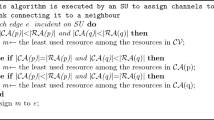Abstract
Cognitive radio technology is an effective method to improve the utilization and efficiency of radio spectrum. Cognitive radio technology solves spectrum scarcity problem by allowing cognitive users to use spectrum holes when primary users are absent. Cognitive radio networks are classified according to the infrastructure into: (A) centralized cognitive radio networks and (B) cognitive radio ad-hoc networks. The cognitive media access control (MAC) protocols are the master key of designing cognitive radio network. These allow cognitive users to identify and use the available frequency spectrum in a manner constrains the levels of interference to the primary users. Cognitive radio MAC protocols can be classified into: (A) random access control protocol (B) time slotted control protocols (C) hybrid protocols. In this paper, the dynamic open spectrum sharing (DOSS) MAC protocol is proposed as an example for random access control protocol. Due to the collision among users, the network throughput will be reduced. In order to enhance the performance of DOSS protocol, a back-off algorithm (BOA) will be executed and analyzed to enhance the network throughput. An optimum number of data retransmissions that decrease blocking and dropping ratio are investigated. Moreover, two accessing channels techniques for the proposed algorithm will be presented: fixed channel allocation (FCA) and dynamic channel allocation (DCA) schemes. DCA scheme allows to users to choose the control channel in a dynamic manner. The dynamic behavior decreases the limitation of control channel saturation. So, it can increase the network throughput. The performance analysis of the FCA and DCA schemes for the proposed protocol will be simulated. Finally, the performance analysis of DCA scheme of DOSS mac protocol with BOA will be investigated.










Similar content being viewed by others
References
Staple, G. G., & Werbach, K. (2004). The end of spectrum scarcity. IEEE Spectrum,41(3), 48–52.
Haykin, S. (2005). Cognitive radio: Brain-empowered wireless communications. IEEE Journal on Selected Areas in Communications,23(2), 201–220.
Akyildiz, I., Lee, W., Vuran, M., & Mohanty, S. (2006). NeXt generation/dynamic spectrum access/cognitive radio wireless networks: A survey. Computer Networks,50(13), 2127–2159.
Mähönen, P., & Riihijärvi, J. (2010). Cognitive radio network architectures. In A. M. Wyglinski, M. Nekovee, & Y. T. Hou (Eds.), Cognitive radio communications and networks (pp. 235–260). Oxford: Academic Press.
Henderson, T. C. (2011). Cognitive sensor networks. In B. Bhanu, C. Ravishankar, A. Roy-Chowdhury, H. Aghajan, & D. Terzopoulos (Eds.), Distributed video sensor networks (pp. 207–213). London: Springer.
Zhao, Q., Tong, L., & Swami, A. (2005). Decentralized cognitive MAC for dynamic spectrum access. In First IEEE international symposium on new frontiers in dynamic spectrum access networks, 2005. DySPAN 2005.
Akyildiz, I., Lee, W., & Chowdhury, K. (2009). CRAHNs: Cognitive radio ad hoc networks. Ad Hoc Networks,7(5), 810–836.
Kan, B., Fan, J., & Wang, J. (2012). MAC protocols for cognitive radio networks. Journal of Software,23(7), 1824–1837.
Cormio, C., & Chowdhury, K. R. (2009). A survey on MAC protocols for cognitive radio networks. Ad Hoc Networks,7(7), 1315–1329.
Chen, Q., Liang, Y., Motani, M., & Wong, W. (2009). CR-CSMA: A random access MAC protocol for cognitive radio networks. In IEEE 20th international symposium on personal, indoor and mobile radio communications.
Chen, Q., Wong, W.-C., Motani, M., & Liang, Y.-C. (2013). MAC protocol design and performance analysis for random access cognitive radio networks. IEEE Journal on Selected Areas in Communications,31(11), 2289–2300.
Ma, L., Han, X., & Shen, C. (2005). Dynamic open spectrum sharing MAC protocol for wireless ad hoc networks. In First IEEE international symposium on new frontiers in dynamic spectrum access networks, 2005. DySPAN 2005.
IEEE Wireless Communications. (2004). IEEE Wireless Communications, 11(6), 01–10.
Walke, B., Berlemann, L., Hiertz, G., Hoymann, C., Forkel, I., & Mangold, S. (2006). Wireless communication—basics. IEEE 802 Wireless Systems.. https://doi.org/10.1002/9780470058800.ch2.
Roy, S., Kundu, S., Ferrari, G., & Raheli, R. (2012). Cognitive radio CDMA networking with spectrum sensing. International Journal of Communication Systems,27(10), 1582–1600.
Akyildiz, I., Lo, B., & Balakrishnan, R. (2011). Cooperative spectrum sensing in cognitive radio networks: A survey. Physical Communication,4(1), 40–62.
Mishra, M., & Saxena, P. C. (2012). Survey of channel allocation algorithms research for cellular systems. International Journal of Networks and Communications,2(5), 75–104.
Eslamnour, B., Zawodniok, M., & Jagannathan, S. (2009). Dynamic channel allocation in wireless networks using adaptive learning automata. In 2009 IEEE wireless communications and networking conference, 2009.
Akyildiz, F., Lee, W. Y., Vuran, M. C., & Mohanty, S. (2008). A survey on spectrum management in cognitive radio networks. CSE Journal, 46(4), 335–355.
Al Attal, A., Hussin, S., & Fouad, M. (2019). Dynamic open spectrum sharing (DOSS) MAC protocol with back-off algorithm. Egyptian Computer Science Journal, 43(2), 13–15.
Xie, N., Zhang, L., Wu, J., & Wang, H. (2015). An adaptive back-off algorithm based on channel utilization for IEEE 802.11. Wireless Personal Communications,83(4), 2965–2973.
Pandit, S., & Singh, G. (2015). Back-off algorithm in cognitive radio MAC protocol for throughput enhancement. IEEE Transactions on Vehicular Technology,64(5), 1991–2000.
Wei, Z.-H., Hu, B.-J., & Lin, Z. (2019). Multichannel MAC protocol with dynamic back-off contention for distributed cognitive radio networks. EURASIP Journal on Wireless Communications and Networking, 2019(1).
Author information
Authors and Affiliations
Corresponding author
Additional information
Publisher's Note
Springer Nature remains neutral with regard to jurisdictional claims in published maps and institutional affiliations.
Rights and permissions
About this article
Cite this article
Al Attal, A., Hussin, S. & Fouad, M. Performance Analysis of Different Channel Allocation Schemes of Random Access (RA) MAC Protocol with Back-Off Algorithm (BOA). Wireless Pers Commun 112, 1981–1993 (2020). https://doi.org/10.1007/s11277-020-07135-2
Published:
Issue Date:
DOI: https://doi.org/10.1007/s11277-020-07135-2




